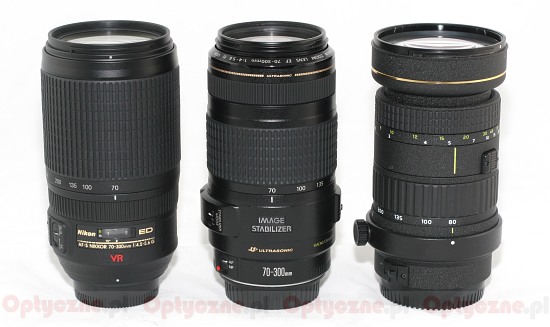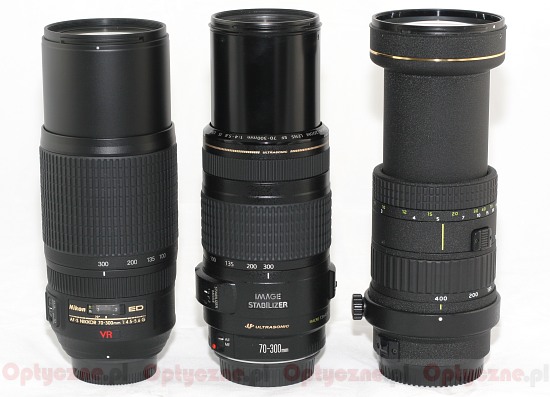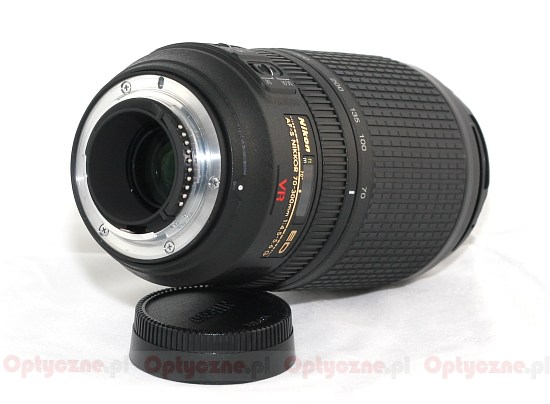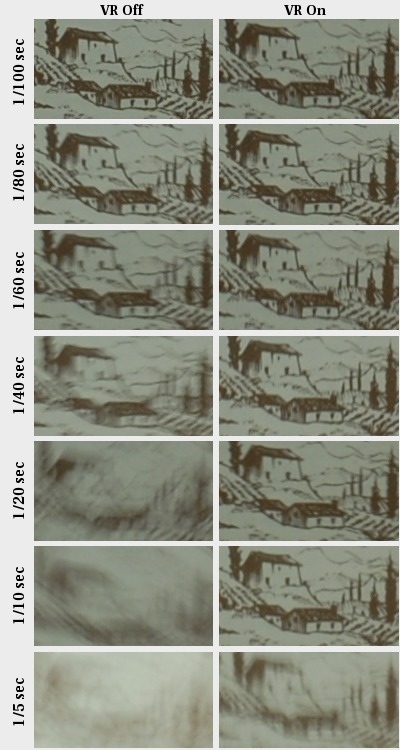Nikon Nikkor AF-S 70-300 mm f/4.5-5.6G IF-ED VR
3. Build quality and image stabilization
 |
 |
Please Support UsIf you enjoy our reviews and articles, and you want us to continue our work please, support our website by donating through PayPal. The funds are going to be used for paying our editorial team, renting servers, and equipping our testing studio; only that way we will be able to continue providing you interesting content for free. |
- - - - - - - - - - - - - - - - - - - - - - - - - - - - - - - - - - - - - - - - - - - - - - - -
First thing that attracts our attention is the size of the front element, the biggest in the Nikkor and the Tokina, the smallest in the Canon. Logically speaking if the company wanted to save, the Nikkor would have the smallest front element. The Canon’s aperture changes from f/4.0 to f/5.6; the Nikkor’s is a tad worse - from f/4.5 to f/5.6. In the case of the Tokina, the f/5.6 aperture can be reached at 400 mm – it means that the maximum effective aperture gathering light is 71.4 mm in diameter. The Nikkor reaches f/5.6 at 300 mm so its aperture’s size amounts to 53.6 mm. A fundamental difference. In this category Nikon scored a big plus then. The company didn’t go in the direction of artificial savings and the big size of the elements suggests images of good quality and without vignetting. Whether it is really the case we’ll find out in the following chapters.
 |
Although I’m a daily user of the Canon 70-300 IS and I don’t complain about its quality, holding the Nikkor in hand I have an impression that it is more solid. Certainly the inner tube, which is shorter and wider at the same time, influences such an impression – it extends forward on zooming. The impression is complemented by a significantly bigger zoom ring and a clear distance scale which the Canon lacks. The manual focus rings are of the same width and similar to the touch but once again the Nikon’s mechanism seems to work more steadily allowing minimally more precise movements. Which of these lenses is more solid it remains to be decided by their users after several months or even years of operation.
The lens’s construction consists of 17 elements in 12 groups and two of them are made of low-dispersion ED glass. Inside we also find a circular aperture with 9 diaphragm blades and an SWM motor, which is supposed to guarantee a silent, efficient autofocus work. The lens’s dimensions (diameter and length) are 80 x 143.5 mm; it weighs 745 grams and it uses filters with a diameter of 67 mm. In its case we get sharp pictures from already 1.5 meters.

It’s worth adding that the buyer gets a petal-type lens hood and a soft case included with the lens in box.
Stabilization
The new Nikkor is equipped with the stabilization system (VRII) which is supposed to give sharp pictures at the exposition time by four degrees longer than in the conventional instruments. Is it really the case? Let’s have a look at the photos below.

You can notice the first symptoms of blur near the 1/80 second exposition time with the stabilization off. With the stabilization on the similar effects can be seen not until 1/8 or 1/6 second – it indicates that the stabilization efficiency is at the level of 3.4 EV.
What’s interesting, although Nikon states that the stabilization efficiency reaches 4 EV in its lens, its competitor from the Canon stable gives the value of 3 EV. The tests show that both lenses in this category fare very much alike.






